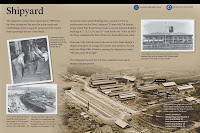Today's date marks the ninety-first anniversary of the arrival of the first submarine division in Pearl Harbor. Submarine Division Fourteen, consisting of six R-boats numbering R-15 through R-20, arrived in Pearl Harbor on June 25, 1919 and served in Hawaii for the next eleven years.
State of the art for their time, the Navy built R-class boats as the First World War came to an end. The subs weighed in at about 600 tons, measured at 186 feet in length, and carried a crew of only twenty-nine Sailors. The R-18 made history at the fledgling base as the first submarine to moor at Pier 1, located at Pearl Harbor’s Quarry Point. The other five boats anchored at nearby Kuahua Island, along with the division’s tender, the USS Beaver, until more improvements occurred at the piers. Kuahua functioned as a temporary submarine facility until February of 1920. The construction of facilities at Quarry Point lacked funding at the time that the new submarines arrived. As a result, the crews of the R-boats were forced to find shelter in tents provided by the Beaver. Once described as a “swamp and cactus covered wasteland,” Quarry Point posed a challenge for the submariners to establish a livable environment. They cleared the land and installed temporary facilities shipped over from France following America’s withdrawal from Europe at the end of World War I.
Lieutenant Commander Felix X. Gygax, a man with an unforgettable name and a distinguished career as a pioneer in the submarine business, was the first commanding officer of this small contingent. He holds the distinction of the first Officer in Charge of the Submarine School in new London, Connecticut. However, it was his replacement who eventually rose to naval legend.
 On July 17, 1920, the Executive Officer on board the battleship USS South Carolina relieved Commander Gygax as Commander of Submarine Division Fourteen, of the new division tender USS Chicago, and of the Submarine Base. His name was Commander Chester W. Nimitz. Despite the economic restraints placed on much of the military’s operations in the years following the war, Nimitz was largely credited with providing the base with its earliest infrastructure using surplus equipment left over from the wartime expansion. The first permanent structure was built on Pearl Harbor sub base in 1923. Nimitz left Pearl Harbor in 1922 for the Naval War College, unaware of the historic circumstances that would necessitate his return twenty years later.
On July 17, 1920, the Executive Officer on board the battleship USS South Carolina relieved Commander Gygax as Commander of Submarine Division Fourteen, of the new division tender USS Chicago, and of the Submarine Base. His name was Commander Chester W. Nimitz. Despite the economic restraints placed on much of the military’s operations in the years following the war, Nimitz was largely credited with providing the base with its earliest infrastructure using surplus equipment left over from the wartime expansion. The first permanent structure was built on Pearl Harbor sub base in 1923. Nimitz left Pearl Harbor in 1922 for the Naval War College, unaware of the historic circumstances that would necessitate his return twenty years later.  The submarine base at Pearl Harbor experienced many changes through the years. The base remained inadequately funded until the 1930s drew to a close and the United States slowly awakened to the “gathering storm” in Europe. Following America’s entry into World War II, hundreds of workers funneled through the base and dozens of temporary structures required wholesale changes to the geography of the base. Inevitably, it became a vital center of undersea operations in the Pacific.
The submarine base at Pearl Harbor experienced many changes through the years. The base remained inadequately funded until the 1930s drew to a close and the United States slowly awakened to the “gathering storm” in Europe. Following America’s entry into World War II, hundreds of workers funneled through the base and dozens of temporary structures required wholesale changes to the geography of the base. Inevitably, it became a vital center of undersea operations in the Pacific.But what of the old R-boats, the first tenants of Quarry Point?
Surprisingly, all of the subs served through World War II as training vessels and most transferred to the U.K. under the Lend-Lease program. Eventually, the Navy scrapped them.
Tragically, the R-19, later redesignated SS-96, sunk when the Canadian vessel HMCS Georgian rammed the submarine on June 21, 1942 in the western Atlantic. All hands were lost.


































